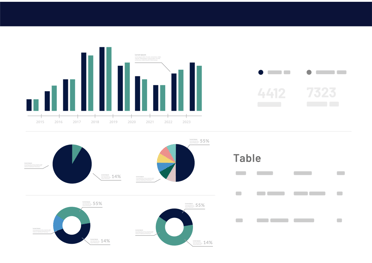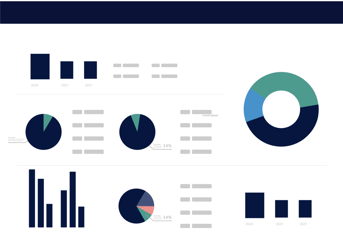The mass adoption of electric vehicles and the need to accelerate EV charging infrastructure has opened various business opportunities and attracted many new entrants, from new start-ups to large enterprises. With a common drive for raising ROI and utilisation on charging infrastructure investments, it is imperative for businesses to have reliable data for informed decision-making.
Charge point operators (CPOs) cope with growing networks and increased demand for their services. The drive for increased utilisation and ensuring network stability of their charging infrastructure, while e-mobility service providers (EMSPs) want to ensure that EV drivers use their service to charge their vehicles by providing a seamless and user-friendly experience. Both aim to increase their return on investment in a timely manner and secure a significant market share in the mobility of tomorrow.
In this blog, we’ll show you how to use business intelligence to make data-driven decisions to plan or improve your charging infrastructure or service. The new analytics module in the OCEAN charge point & energy management system is based on Power BI. It helps you keep track of key data about your infrastructure and users by providing insights and reports on an ad hoc or time-based basis. The reports are designed to meet management’s, operational team’s, and your business partner’s needs . We have created special reports for different users based on Power BI. The preset reports have been developed and designed to answer all the questions that the following users usually need:
- Infrastructure planner (CPO - charge point operator)
- Infrastructure operations managers (CPO)
- Help desk/support manager (CPO)
- CRM manager (EMSP - e-mobility service provider)
- Business/service analyst (EMSP)
- Payment manager (EMSP)
- Marketing manager (EMSP)
Infrastructure planner (CPO)

Infrastructure utilisation: Get insights on how your infrastructure is utilised and strategise infrastructure charging areas, types of chargers, and tariffs. Utilisation is correlated to connector statuses, so you can gain an understanding of what is happening in the field.
Infrastructure operations manager (CPO)
- Infrastructure operations statuses: With the report, you can investigate if there is any correlation between the charger statuses and connector type or firmware versions that is causing issues in the infrastructure area. You can also export the report for a particular SubCPO operator.
- Infrastructure errors: Understand which errors are most common on your charging infrastructure. By filtering, you can narrow down which error event types are most frequent on which charger and firmware version. You can also see which owner has the most issues.
- Communication outages: In case of communication outages, EV drivers cannot start their charging session (charger out of communication or appears unavailable). The important information is the station model and firmware version, as it would tell you which firmware causes the most trouble.
Help desk/support manager (CPO)

- Frequent issues: Discover patterns using multiple filters that tell you which issue categories are the most frequent, on which chargers, and from which source the tickets are coming from.
- Team efficiency: Compare team efficiency with the previous year by considering team growth, allocation, number of issues, number of steps needed to resolve an issue, station model, and energy transfer type. See how team efficiency changes during peak days and hours.
- Issue categorisation: Investigate how well your customers assign an issue category and sub-category when reporting a support issue. Based on this data, you can improve your copy or even make more changes that help the end users assign the issue category correctly.
CRM manager (EMSP)
- Registration patterns: Observe registration patterns to improve your service and customer needs. By observing data such as the average time to approve registration and the time until the user’s first transaction, you can find opportunities for improving your service.
- Driver growth: Discover the number of drivers on your infrastructure. Distinguish between different driver types from physical to business users. See which contract types are the most popular ones and understand what kind of EV models your customers are driving, so you can better assist them when support is needed.
- Customer segmentation: Find shared characteristics among customers that are paying for charging services. The drivers vary from being a single user to managing several drivers through the fleet portal.
Business analytics (EMSP)
 Charging session analysis: The comprehensive report allows you to discover how the energy is used (AC/DC), fault reasons, and growth per time for different scenarios and customer types. Investigating the fault reasons in detail can impact the overall user experience.
Charging session analysis: The comprehensive report allows you to discover how the energy is used (AC/DC), fault reasons, and growth per time for different scenarios and customer types. Investigating the fault reasons in detail can impact the overall user experience. - Session trends: By observing session trends, you can see which contract types are most suitable for your customer base and adapt the subscription packages accordingly.
- Customer behaviour: Discover what types of contracts are popular among customer groups. See insights on where customers are charging the most and which locations are most frequently used.
- Invalid sessions: Invalid sessions report provides an overview of the sessions that have invalid data. OCEAN marks these sessions with different validation statuses. We are distinguishing between unusual behaviour detected by the system or reported by the Operator (also the user).
- Offline & unfinished sessions: Offline sessions usually start offline, but the users can still use the infrastructure. Unfinished sessions are connected with charging station models. If the charger has never sent the stop transaction command, billing cannot be performed, and this eventually means loss of funds.
- Authorisation failures: Based on authorisation errors, you can see what is happening on the field and improve the user experience by sending notifications or changing the strategy in the app to explain to the customers what the prerequisites for successful charging are.
- Charging reservation analysis: How your customers are using reservations may directly affect the utilisation of the charging infrastructure. Understand how your customers are using reservations.






